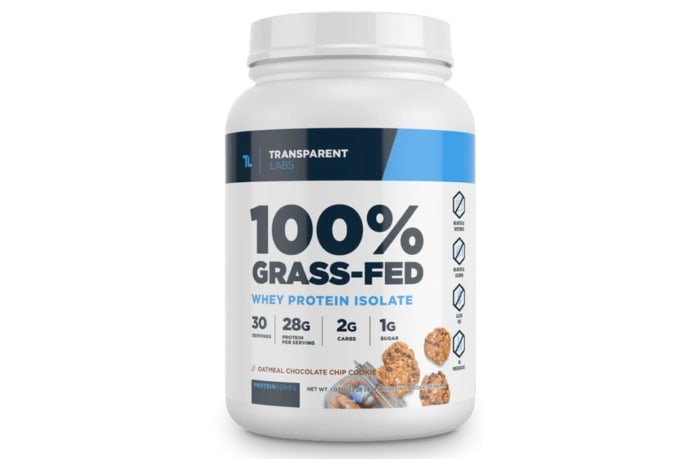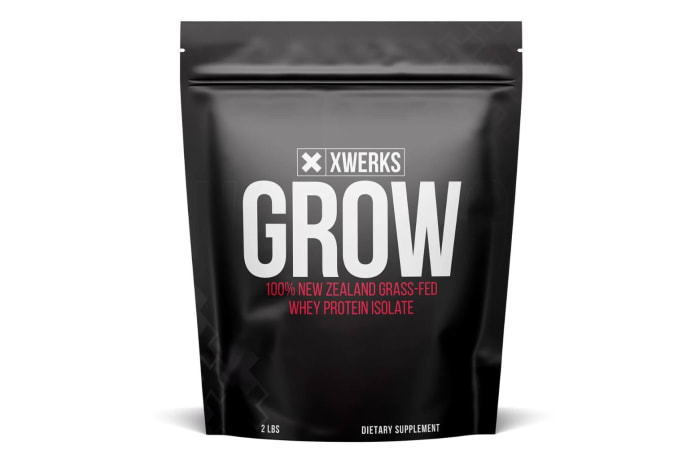The products featured in this article have been independently reviewed. When you buy something through the retail links on this page, we may earn commission at no cost to you, the reader. Sports Illustrated editorial staff are not involved in the creation of this content. Learn more here.
Protein is incredibly important in any diet regimen because of its vital role in body recomposition. Proteins provide the amino acids that our bodies use to build our muscles. Out of 20 amino acids total, there are nine that are essential, meaning our bodies cannot produce them. We must get them through our diets, and that fuel has to be provided in the form of protein.
However, if you’re eating protein to lose weight, the best sources of protein may not be the ones you most associate with protein-maxing. “When you’re consuming stuff like red meats, or more fatty fish like salmon, you’re getting a lot of calories from the protein, but also from the fat that's in those types of foods,” sports nutrition coach Pete Nastasi says.
The key: Prioritize leaner meats and low-fat dairy (think: chicken breast, Greek yogurt and low-fat cottage cheese), while sprinkling in “bonus” alternatives that you may have never realized were solid sources of protein. “I start with integrating beans, lentils, some nuts and seeds into a client's diet. And that's a good kind of bonus source of protein that they're getting throughout the day,” Nastasi says. A protein powder is also a good tool as you revamp your diet, especially a protein powder formulated toward weight loss, if that’s your aim.
Nastasi says he’s taken a plant-based protein approach. While a vegetarian diet may not be for everyone, it is an approach that lends itself to eating some of the best sources of protein. “If you do eat fairly plant-based, those obviously are very lean sources of protein. With tofu, tempeh, soybeans, etc., you're not really getting much fat or carbohydrates.”
We’ve broken down each of these lean protein sources for you—why they’re good sources of protein; some delicious and accessible ways to prepare them and the types of diets that they best lend themselves to.
This content is meant to be informative, but should not be taken as medical advice. It is not intended for use as diagnosis, prevention or treatment of health problems. Always speak with your doctor before starting any new supplement or exercise regimen.
Lentils
Amount of protein: 9 grams per 100-gram serving
Lentils are one of the best sources of protein that also pack a punch of fiber. Each 100 gram serving of lentils averages nine grams of protein and almost eight grams of fiber, with very little fat (.38 grams) to account for. Dal, a staple soup from India, is a fantastic way to prepare and enjoy lentils. As a legume, lentils are also one of the many low-cholesterol sources of protein. A diet low in cholesterol offers health benefits like a lowered risk of heart disease.
Peanut Butter
Amount of protein: 22.5 grams per 100-gram serving
Peanut butter, or other plant-based butters like almond butter, makes an excellent source of protein. The caloric density of peanut butter is especially great for those who are in a period of bulking, or trying to make significant muscle gains. I personally enjoy noshing on celery with raisins, and add some dried fruit if I’m feeling nostalgic about the classic “Ants on a Log” celery/peanut butter/raisin childhood dish.
Chicken Breast
Amount of protein: 23.2 grams per 100-gram serving
Chicken breast not only has a solid amount of protein per serving (31 grams per 100 gram serving) and brain-boosting B-vitamins, but is one of the most versatile sources of protein in the kitchen. Baking, grilling, stir frying, sous vide and air frying are among the many ways to prepare chicken without adding excess fats. You can also try a healthy meal delivery service for creative inspiration to prepare chicken.
Protein Shakes
Amount of protein: 58.1 grams per 100-gram serving
A quality protein powder frothed into a protein shake is an excellent way to ensure you’re not only upping your protein intake, but getting a complete protein, i.e., one that provides all nine of the essential amino acids. Plus, any additional ingredients in your shakes, like bananas, can be packed with macronutrients like potassium and magnesium, which studies have shown to be beneficial for heart health. If you’re lactose-intolerant and need to keep dairy products out of your shake, opt for milk alternatives like almond or rice milk rather than juice, which can add a significant amount of sugar. While protein powders have varying macros based on which one you choose, they generally have 20 grams or more of protein per serving.
Chickpeas
Amount of protein: 8.86 grams per 100-gram serving
A typical cup of cooked chickpeas (around 164 grams) delivers 14.5 grams of protein and 12.5 grams of dietary fiber. It’s no wonder they’re a staple of the Mediterranean diet, a diet lauded by experts for its associated health benefits, like lowered blood pressure and blood sugar. Chickpeas can serve as a delicious main event in stews and curries, or act as a sideline player sprinkled in your salad. Smash them up to make hummus if you want chickpeas on-the-go.
Cottage Cheese
Amount of protein: 11.1 grams per 100-gram serving
Dairy-based protein sources like cottage cheese have the added benefit of calcium. One serving of cottage cheese (113 grams) has nearly 100 grams of calcium, a critical nutrient for bone health. Cottage cheese is also a great food on-the-go. Add blueberries for a pop of color, flavor and antioxidants.
Greek Yogurt
Amount of protein: 9.95 grams per 100-gram serving
Full-fat varieties of Greek yogurt are a great way to pack in healthy fats and avoid unhealthy fats (i.e. saturated fat). If I feel I haven’t gotten enough protein for the day, I’ll often add Greek yogurt sweetened with monk fruit or stevia to an afternoon smoothie as a delicious alternative to milk.
Quinoa
Amount of protein: 4.4 grams per 100-gram serving
Quinoa is a whole grain that can be used in place of rice for many dishes. While it's not incredibly high in protein itself, it has more than most other grains, making it a good choice for a variety of meals. Quinoa breakfast bars and cereals have also risen in popularity, offering a healthy alternative to the mostly carb-packed cereals that fill grocery store shelves. Here’s a favorite cereal trick of mine that I got from nutrition expert Harley Pasternak: Fill 85 percent of your bowl with the healthy cereal, and sprinkle the sugary stuff on top as a treat.
Edamame
Amount of protein: 11.9 grams per 100-gram serving
Edamame is an easy snacking source of protein (about 12 grams in a 100 gram serving) on its own. You can also enjoy a simple preparation with salt or tamari (a Japanese sauce made from fermented soybeans).
Black Beans
Amount of protein: 8.86 grams per 100-gram serving
Can you name a more iconic duo than beans and rice? The combination is popular for a reason, since the two combined create a complete amino acid profile. Black beans also provide a dose of fiber, with 8.7 grams per 100-gram serving. If you’re tired of plain old beans and rice, try black beans on whole wheat toast or a black bean dip. Taco soup with black beans is also a delicious freezer meal for weeks you’d rather not cook.
Lean Beef
Amount of protein: 17.2 grams per 100-gram serving
It’s true that red meat is generally not a heart-healthy choice. However, in moderation, lean beef is an excellent way to get protein with fewer drawbacks, like excess fats and calories. A four-ounce (113 grams) cut of lean beef will average about 19.4 grams of protein. Lean beef is a great core ingredient for stir fries, or tasty addition to top off a taco salad.
Related Post: The Best Meat Delivery Services
Pumpkin Seeds
Amount of protein: 30.2 grams per 100-gram serving
Pumpkin seeds are highly calorie-dense, so rather than eating them by the handful, they make a great addition to other dishes, like banana bread or salads. Like chia seeds, they’re also a protein-rich addition you can throw in the blender for your next shake or smoothie. They contain 30.2 grams per 100-gram portion.
Pistachios
Amount of protein: 20.2 grams per 100-gram serving
Pistachios are a versatile snack packed with protein—they contain 20.2 grams per 100-gram serving. You can eat them roasted, raw, unsalted or salted. Grind them up for a delicious ice cream topper as well.
Spirulina
Amount of protein: 57.5 grams per 100-gram serving
Although spirulina sounds like a Disney princess, it is in fact a type of blue-green algae, an excellent source of protein (57.5 grams in a 100 gram serving) and a noted anti-inflammatory agent. For that reason, you’ll often see spirulina in the best greens powders and supplements for muscle recovery.
Seitan
Amount of protein: 24.7 grams per 100-gram serving
Seitan is a wheat-based hearty meat alternative with high protein content (nearly 25 grams per 100 grams) that makes a great substitute for beef (tempeh is another good option). The chewy texture can be flavored in many different ways, so pretty much anywhere you’d see beef you can substitute seitan, from a reuben sandwich to a stir fry or soup.
What Is Protein?
At its most molecular level, protein is defined as a chain of amino acids (often referred to as the “building blocks” of protein) that are connected via peptide bonds, kind of like a string of pearls.
When we eat foods with protein, the protein is broken down into the individual amino acids that comprise it. Some amino acids can be created in-house, i.e. by our bodies, however others are considered “essential” because they can only be acquired from an outside source, i.e. food.
Benefits of a High Protein Diet
Protein is critical for weight loss for a number of different reasons, Nastasi explains. “The protein that you consume has what's called the 'highest thermic effect of food,'” he says. “Basically, that means protein takes your body the most energy to digest and absorb.”
That’s in contrast to carbohydrates and fats, which are digested and converted more easily into fat stores by the body.
The high thermic effect especially plays an important role when you’re eating excess calories, Nastasi says. “Ideally, we want to convert as much of those extra calories into muscle mass rather than body fat,” he says. For that reason, a high protein diet is pursued often in tandem with a resistance training regime, to build muscle.
On the flip side, if you’re in a daily calorie deficit, you also want to preserve as much of your lean muscle mass as possible, something a high protein diet can help with.
How Much Protein Should I Eat a Day?
The amount of daily protein your body needs will depend on a variety of factors, including age, sex and lifestyle. If you are doing resistance training, studies indicate that daily protein should fall between 1.6 grams and 2.2 grams per kilogram of body weight.
If you’re more sedentary, your protein needs are still substantial, but less steep: You’ll probably need about 0.8 grams of protein per kilogram of body weight per day. You can use an online calculator from the USDA if you’d like a more clear-cut figure to aim for.
If you struggle with organizing your diet to include that much protein, psychology-based tools like Noom can help you carve the pathways in your mind and environment to create the path of least resistance toward healthy eating and getting more protein.
Our Favorite Protein Powders
- Transparent Labs 100% Grass-Fed Whey Protein Isolate
- Transparent Labs Organic Vegan Protein
- XWerks Grow
Transparent Labs 100% Grass-Fed Whey Protein Isolate
Whey protein isolate is a solid, efficient source of protein when looking at powders, as opposed to a whey protein concentrate blend, which has more carbs and fat. Transparent Labs gives you the choice of several flavors for its whey protein isolate, including chocolate peanut butter, french vanilla and strawberry. You don’t have to sweat that these fun flavors have added calories though—they’re all sweetened with zero-calorie stevia. Transparent Labs is also certified free of artificial additives, sweeteners or preservatives.
Transparent Labs Organic Vegan Protein
If you’re on a plant-based diet, you’ll want to skip products with whey, a cow’s milk derivative. Fortunately, Transparent Labs has you covered with its Organic Vegan Protein. The blend combines yellow pea and rice protein to make a complete protein, and like its other products and a nod to its name, Transparent Labs is clear about exactly what goes into its products.
XWerks Grow
XWerks Grow is a grass-fed whey protein isolate-based powder, micro-filtered to take out the fat, carbohydrates and lactose. Set yourself up for success with a subscription plan that can be shipped in 15, 30, 60 or 90-day increments. XWerks is also flavored with stevia to make the blend more appealing as a shake, but without the added sugar. Choose from strawberry, chocolate, vanilla or peanut butter.
Final Thoughts
With all this talk of “good” protein, it may be tempting to reorganize your diet completely to cut out fattier, higher-carb meats, fish and dairy. But be warned: Unless you’re allergic or otherwise reactive to a certain ingredient, there aren’t really “bad” proteins. A healthy diet is all about moderation. You should enjoy those proteins with greater amounts of fats and carbs, like brisket or salmon (which offers benefits of its own, like cognitive-sharpening omega-3 fatty acids), but think about them in the context of your overall diet over weeks and months.
Prices are accurate and items in stock as of publish time.












